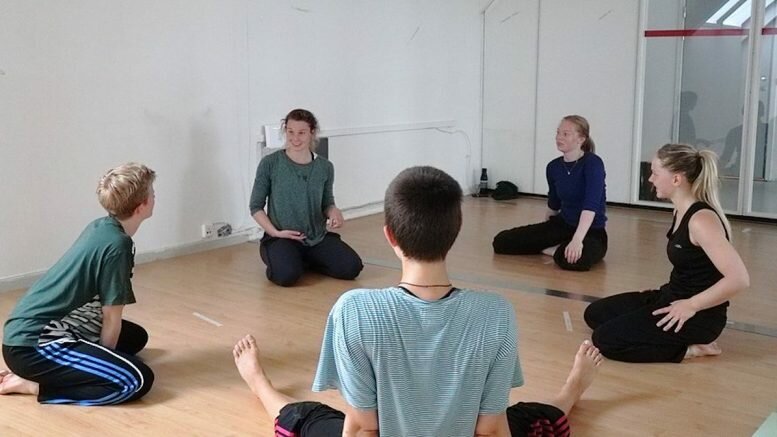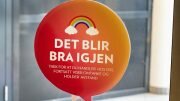Kunst Rom Arbeid (KRA) is a working space for artists and creatives located in Stavanger.
The goal of KRA is to stimulate the cultural scene in Stavanger and offer artists, musicians, and creators an affordable, well-equipped place to work in. Due to COVID-19, however, the hub’s existence is at stake.
We spoke to Eduardo Scaramuzza and Ingvild Maria Thingnes, the co-founders of KRA who are creatives themselves. Eduardo is a photographer and musician and Ingvild is a dancer.
They are both running KRA on a 100% voluntary basis right now. A lot of their time is currently spent generating enough income to cover rent, but also keeping the space tidy, writing applications, and meeting up with members or clients. They volunteer 4-6 hours a day, seven days a week.
Eduardo and Ingvild helped us learn more about KRA and why its survival is important for Stavanger.
Can you give an introduction to KRA?
“KRA offers a shared workspace and a community for artists in the city. We aim to gather the artistic community in Stavanger and contribute to a more inclusive environment and encourage interdisciplinary collaborations.
“Our space has a dance studio, an equipped music room, an art room, an office, and a common room.
“We started in June and we were on our way to build a sustainable business plan for the house to generate income and be able to pay the minimum expenses. We were organizing events and renting spaces out for different activities.
“However, with the second wave of COVID-19 and the new restrictions, we lost our clients and we are unable to have events and collect money to pay our rent. We basically have money for December and a few days in January. Not such a good Xmas gift…
“We have been working so hard to keep the place. We worked on many applications: we built with members a professional dance floor, we organized second-hand markets, we had concerts, performances, masterclasses, and workshops. During our vintage market, we had a flow of 200 people a day visiting, following all COVID-19 restrictions.
“We would love to get help. It will be a big loss for the community to close such a cultural initiative that aims to bring people together. We believe that if we survive these times, we will be able to lift the cultural effervescence in our area.”
How did you decide to open KRA?
“KRA has grown out from a project initiated by Lone Eivindsdottir and Ingvild Maria Thingnes in January called Kråkeslottet. Due to a lack of connection to the artistic community in Stavanger, they rented an apartment at Storhaug for one month and invited a bunch of artists, musicians, and dancers to gather and create together in this house for one month. By the end of the month, the house was filled with art, projects, and people, and a final open event marked the end of the process. About 100 people came to see what had been created, and the next day everything was moved out and the house left.
“KRA grew out of the community and the idea of Kråkeslottet and was established by one of the co-founders, Ingvild, and two of the participants: Lise and Eduardo. The pandemic situation was surprising to us like everyone else, and of course, none of us could expect just how big the impact of this situation would be. We continued our process as best as we could, and by the time we signed the contract for the new space we still imagined to greet a corona-free society by the end of the summer.
“KRA has definitely been of great importance to us during the pandemic situation. This space was created in order to make a more connected artistic society, for artists from different fields to meet each other and to work less isolated. The pandemic definitely didn’t help us with that problem, but it did make us even more sure of the importance of such a community.”
Why do you think it’s important that KRA continues during and after the pandemic?
“Most artists, being dancers, musicians, visual artists, or other professions, are in need of a workspace. If anything, the pandemic only presses the matter. Renting or sharing a dance studio, an atelier, an office or a music studio tends to be expensive, especially for the economy of newly established artists, and a luxury few have access to. KRA offers a shared workspace starting at NOK 250 a month, aiming to give equal opportunities for the local artists in the area of Stavanger, especially targeting the graduating students of the Art School and Faculty of Performing Arts as a way of entering into the professional field.”
Ingvild notes,” KRA is also important for a lot of us because it offers a very rare opportunity of having a collegiate as a freelancer and to feel part of a creative community. The pandemic is causing us to feel more isolated, and KRA assures me that I will always have a community to go back to.
In light of the pandemic situation, I believe KRA is important as an arena that is able to facilitate collaborations and communication between artists following a time where working together has been harder than ever before.”
How does KRA positively affect the community, and prompt art and culture?
“There are a lot of good opportunities for artists in Stavanger, and we wish more artists would stay to see the potential of the city. We hope that having access to a place like KRA will give a better sense of affiliation to the city, open up for new ways of working together, to research and to fail, and to feel the support of an open community.
“KRA is not a stage, so when we do open the doors for an audience it is not to show finished work but to give people a chance to peek into the processes in the house, and to share their ideas and impressions with the artist(s). We will sometimes invite people for workshops.”
What can the local and international community do to help KRA?
“We appreciate all kinds of help and support, and there are lots of ways to help out.
“You can easily support KRA financially through membership plans or/and donations through our website.
“If you want to help out in person, we have a group of volunteers that has been extremely valuable to our work, and whose company has been some of the most enjoyable times at the house! Anyone who wants to be part of the team is welcome to get in touch.
“We also appreciate any help getting or lending tools, equipment, or materials such as wall paint, fabric, furniture, or tools that will benefit our place.”
Who can rent out space and become a member – and how?
“KRA as a working space is interesting for artists and creative people that aim to meet other artists and have an affordable place to work. The rooms are really flexible and able to be shaped following the needs of the majority.
“KRA can be rented for meetings, social gatherings, yoga classes, exhibitions, movie nights, martial arts, or any activities that fit our space.
“The rental process is through the designated webpage or our e-mail ([email protected]).
“There are different types of membership: the Butterflip is for everyone that wants to support monthly and also get some discount on our events but do not need the space to work. The Sparowship, Crowship, and Ravenship are designed for artists and creative minds. They are based on how many hours you can book and if you need to bring some non-members to work with you. To sign up you just need to go to the webpage, make a profile and choose what membership suits you the best. The payment is done on the webpage through Paypal and can be managed on the webpage. Easy to sign up and easy to cancel if you need.”
See more details on plans and pricing here.
Anyone wishing to learn more…
Find KRA’s website here and Facebook page here.
Their Instagram account is @kunstromarbeid.
Source: Norway Today





Be the first to comment on "“Not such a good Xmas gift”: Cultural hub in Stavanger struggles to survive second wave of COVID-19"